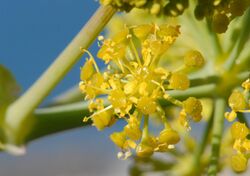Biology:Ferula tingitana
| Giant Tangier fennel | |
|---|---|

| |
| Scientific classification | |
| Kingdom: | Plantae |
| Clade: | Tracheophytes |
| Clade: | Angiosperms |
| Clade: | Eudicots |
| Clade: | Asterids |
| Order: | Apiales |
| Family: | Apiaceae |
| Genus: | Ferula |
| Species: | F. tingitana
|
| Binomial name | |
| Ferula tingitana | |
Ferula tingitana, the giant Tangier fennel, is a species of the Apiaceae genus Ferula. Despite the name, the plant is not a type of fennel proper, which belongs to another genus (Foeniculum).
Ferula tingitana is a tall perennial herb. It has alternate leaf arrangement and yellow, unisexual flowers which, like other Apiaceae, grow in umbels. It grows in scrubland (batha and phrygana) and rocky areas.[1] Its range is the Mediterranean coast, in Spain , Morocco, Lebanon, Syria, Israel, Cyprus, and Turkey.[2] [3] In the 1980s there was chemical interest in esters and ethers extracted from it.[4][5][6]
This species has been considered to have abortive and menstruation-inducing properties.[7] The species has been suggested as a possible identity for the controversial silphium, a plant used as a spice and for various medical purposes in classical antiquity in the Mediterranean region.[8] Among the many uses of silphium was promoting menstruation, and possibly contraceptive or abortifacient properties, which has been suggested to link it to Ferula.
References
- ↑ "Ferula tingitana L.". Flora of Israel Online. The Hebrew University of Jerusalem. Archived from the original on 2012-09-30. https://web.archive.org/web/20120930170723/http://flora.huji.ac.il/browse.asp?lang=en&action=specie&specie=FERTIN.
- ↑ "Ferula tingitana L.". Global Biodiversity Information Facility. http://data.gbif.org/species/3636208/.
- ↑ "Ferula tingitana L.". The Euro+Med PlantBase. http://euromed.luomus.fi/euromed_map.php?taxon=344219&size=medium.
- ↑ Miski, M.; Ulubelen, A.; Mabry, T. J.; Watson, W. H.; Vickovic, I.; Holub, M. (1984). "A New Sesquiterpene Ester from Ferula tingitana". Tetrahedron 40 (24): 5197–5201. doi:10.1016/S0040-4020(01)91270-0.
- ↑ Miski, M.; Mabry, T. J. (1986). "New Daucane Esters from Ferula tingitana". Journal of Natural Products 49 (4): 657–660. doi:10.1021/np50046a016. PMID 3783161.
- ↑ Miski, M.; Ulubelen, A. (1985). "Sesquiterpene-Coumarin Ethers of Ferula tingitana". Journal of Natural Products 48 (2): 326–327. doi:10.1021/np50038a024. PMID 4009187.
- ↑ Jöchlea, W. (1974). "Menses-Inducing Drugs: Their Role in Antique, Medieval and Renaissance Gynecology and Birth Control". Contraception 10 (4): 425–439. doi:10.1016/0010-7824(74)90042-0. PMID 4614935.
- ↑ Koerper, H.; Kolls, A. L. (1999). "The Silphium Motif Adorning Ancient Libyan Coinage: Marketing a Medicinal Plant". Economic Botany 53 (2): 133–143. doi:10.1007/BF02866492.
Wikidata ☰ Q5445601 entry
 |

